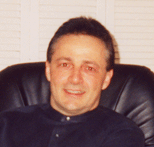System

03 March 2002
"Re-Visit":
08 December 2002
|
System |
 |
03 March 2002 "Re-Visit": |
|
e-mail to: |
In 1975 I immigrated to the United States and settled in South Florida. While still attending high school I began to work and purchased my first system - a Sharp Optonica integrated amplifier, a Thorens turntable with a Sure cartridge and JBL speakers. Since then I've bought and sold numerous systems until I settled down into a minimalist approach to audio (I enjoy home theater as well, but keep my HT system in a separate room). My current listening room is about 25 ft X 15 ft. This apartment living room yields good depth reproduction even without room treatment. I like to use minimal length cables and interconnects, so the amplifier and source are arranged in close proximity to the speakers, several feet away from the back wall, further degrading potential WAF. If there is any doubt among the readers let me say that I am unattached, which allows me to place audio equipment wherever I want without secondary harmonic distortions, which would otherwise be female in nature. Synergy between SET and MOSFET My system is a bit unusual. First, I am not using an active preamp or a passive line-stage. Attenuation takes place on the amp level. Further, the system uses a single source. I chose CD over turntable since I have more CDs and tend to be a bit impatient when it comes to switching media. Finally, I've created (quite by accident) a synergy between SET and MOSFET. My little amp can in fact play Heavy Metal and House music at above moderate levels because the Klipsch RP3 speakers employ 440-watt amps to drive the 10" woofer at levels down to 27 Hz. However, since I have not added base traps the amps are run flat, which still yields a pleasant amount of bass. Everything ZEN The ZEN amp is the heart of my system and I am enthusiastic about this SET. Similar amps like the CAD-2A3 by Cary Audio and Wavelength's Gemini are more cost prohibitive in terms of initial investment and maintenance. The ZEN will deplete only a small percentage of your bank account compared to the price of most SETs and it uses a cost-effective pair of Svetlana SV83 output tubes, which are fast and sound quite good. The amp further uses a single Svetlana, 6N1P, dual-triode tube in the driver circuit (I have replaced this with a more precise Sovtek 6922 - an overall improvement in sound quality). Together with the Philips 5Y3GT rectifier retubing the amp is downright cheap (a 5Y3GT should last many years anyway). The ZEN is visually not appealing as far as mass marketing is concerned. However, it is hand-built to order using quality parts and fine workmanship. Personally I actually like the "Flash Gordon" look of the little amp. Music Preferences I prefer CDs for convenience, but I am picky when it comes to music labels. I enjoy most music, but I prefer single instrument acoustic music (50%). This can be jazz, blues or pop. I also enjoy European and Latin pop (12.5%). I like some classical music, but prefer interpretations on guitar, violin or cello (12.5%). Last, but not least I enjoy most well-recorded indie, rock, metal and industrial music (25%). Evaluation CDs 1. Earl Klugh - Solo Guitar (Warner Brothers) 2. Leo Kottke - One Guitar, No Vocals (Private Music) 3. Cowboy Junkies - Trinity Session (RCA) 4. Hellbound on my Trail - Songs by Robert Johnson (Telarc) 5. Rusted Root - When I Woke (Polygram Records) 6. Kid Rock - Devil Without A Cause (Atlantic) 7. Staccato - Audio Test CD (Staccato, Germany)
Michael's comments about his System: AA: "Mike, how would you describe your system's sound?" MS: "Natural, soft, open and detailed." AA: "Do you think there is room for improvement?" MS: "Certainly, little tweaks here and there will balance the system a bit more." AA: "Have you got plans for upgrading?" MS: "Maybe - I really
miss the Reference 3a monitors I once owned. I might buy
another pair down the road, as well as some Acoustic Lens
room treatment." General Information Name: Michael H Schelb Age: 42 Status: Single Residence: Boca Raton, Florida, USA
|
Home